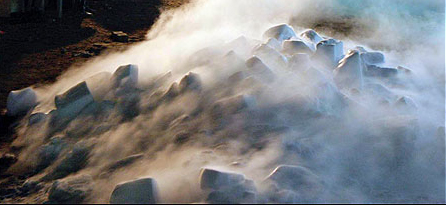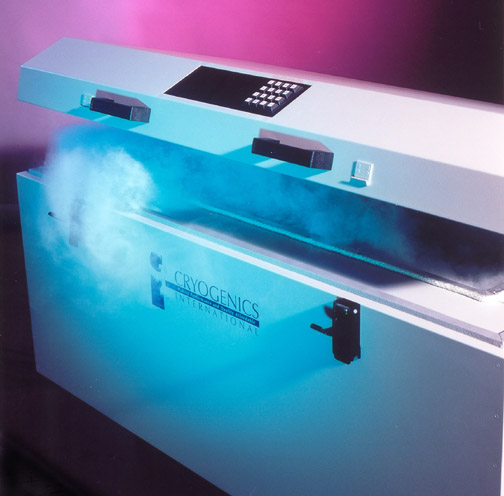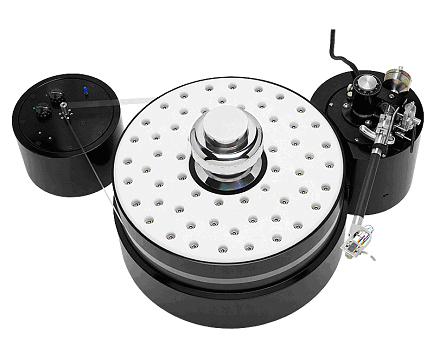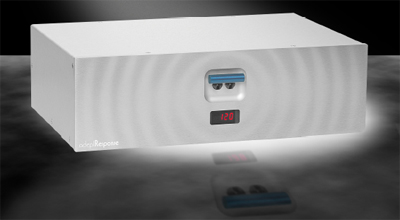|
You are reading the older HTML site
Positive Feedback
ISSUE
21
An interview with Charles Beresford of Cryogenics International -
Hey, it's REALLY, REALLY not just a bunch of dry ice! This is the second in a series of interviews with various people in the cryo-industry as to the what's and why's of cryoing - more to come!
So what's the deal with cryogenics? Cryogenics is actually a very generic term that deals with the production and effects of very cold temperatures. Cryogenics International is specifically involved in controlled deep cryogenic processing. This process is used for improving the desired properties/qualities of many materials and products. It was originally used in industry to improve the abrasive wear life of cutting tools, blades, dies, electrodes, etc.. Deep cryogenic processing applies to the audio industry as a further evolution into the improvement of materials to enhance their performance and tonal qualities. Cryogenics International (www.cryogenicsinternational.com) is located in Scottsdale, Arizona and has offered cryogenic systems and processing to private individuals and industry for over 18 years. We pride ourselves on the highest-quality systems and processing for all audio cables, parts and accessories. How did you get into this? My father had originally tried the cryogenic process with some razor blades and woodworking tools with very good results. Convinced of the process's benefits, we immediately envisioned a large market for improvement. In the past, cryogenic processing involved complicated Sterling Engines and cascade-type systems utilizing Helium. These systems were prone to mechanical failure and inconsistent results. There were also people submerging items into liquid nitrogen and calling it cryogenic processing. This process really caused problems such as dimensional changes, hairline cracks, and sometimes parts failure. We wanted to eliminate all of those negatives. Our first step was to make the process uniform, consistent, and repeatable with high-quality processing systems. We started Cryogenics International in 1986, in order to bring computer-controlled deep cryogenic processing systems and processing services to industry. In 1988, Cryogenics International was granted a U.S. Patent for its revolutionary computer-controlled, liquid nitrogen-based, deep cryogenic processing system and process. We were fortunate to have Dr. Helmut Trucks, P.E., one of the premier materials scientists work with us early on in discovering the mechanisms for the deep cryogenic process. Much of the research up to that time was conducted on steels, and based on austenite (soft carbon) to martensite (hard carbon) transformation as the reason for improvement. Dr. Trucks brought the physics side of the equation to light by stating that cryogenic temperatures removed much of the atoms' built-in kinetic energy, allowing the materials structure to align in a denser, more uniform pattern. This helped explain why materials other than steel responded so well to the deep cryogenic process. What is your background/history in audio? On a personal level, I have always enjoyed high-end audio. This could be because of my father as well. In my youth, he owned a very nice McIntosh audio system and always impressed upon my brother and I, the joys of good music. I have always purchased high-quality audio equipment for personal enjoyment. In operating Cryogenics International, I had the opportunity to process some optics for government telescopes. The agency informed me that many distortions were removed, and the optical properties improved. I then had the idea to process a few CDs in the late 1980s to see what would happen. To my amazement, the improvement was dramatic. In order to try to understand the audio mechanism at work, I contacted Robert Harley, who was with Stereophile at the time. After a nice conversation and a great deal of research later, an answer was at hand. Stresses induced from the CD's manufacturing process causes birefringence when the player's laser tries to read the disk, degrading sound quality. Our precisely controlled, deep cryogenic process stress-relieves the polycarbonate disk, making it more optically clear. This greatly reduces birefringence and improves audio quality. Another cross-industry idea was made evident after seeing the dramatic improvement copper welding electrodes showed after our process. The result was longer electrode life and a lower electrical current needed to produce the same quality welds. This was all I needed to know to try processing electrical cables, spark plugs, and electrical conductors of all types. As a business, Cryogenics International has been processing audio equipment, cables, electronics, vacuum tubes, etc. for audio manufacturers and listeners for many years. The improvement from our process is self-evident and it is fun and exciting bringing this benefit to the audio community. Can you take us on a step-by-step process on how you cryo something? This will be a general overview of our process. We have several different-sized systems that we use for processing. Our largest has about 32 cubic feet of internal capacity, and is large enough to process multiple engine blocks and related parts. The material being processed is gently loaded into the system. The lid is then closed and the computer is programmed with the appropriate information. The temperature in the chamber is slowly and precisely lowered from ambient to -320°F. This can take anywhere from 8 to 14 hours, which is always far less than a degree per minute. For audio parts and components, our descend rate is around a half-degree per minute. This lengthens our process, requiring more LN2 for processing (and therefore more costly to perform), but we know from years of experience that it is well worth the time and expense. We allow the nitrogen to enter the chamber through a phase separator for safety, and very importantly, to purge the chamber of air and moisture. Within this inert nitrogen atmosphere, condensation will not accumulate. The soak phase of the process maintains -320°F for at least 24 hours, and usually more. This is important because all molecular motion slows dramatically at very cold temperatures. In order to assure complete transformation, one must maintain as cold a temperature as possible (the soak) for periods longer than 20 hours. Our system then warms the chamber to ambient temperature over a period of 12 to 24 hours, sometimes longer depending upon the load. This precise control and long time duration ensures that there will never be a large difference in temperature from the outside of a part to the core of the part. This is how it is possible to safely process items with very dissimilar materials and construction.
CI Processing System Are there different ways or methods of cryoing? Unfortunately, yes. And this difference causes much confusion. For instance, we have clients that heard many good things about the process, but tried it somewhere else and did not get the promised results. Then they took a second chance, sent us their cables, tubes, and/or gear, and were blown away by the improvement. There could be many reasons for this difference. Some companies can only reach -290°F to -300°F using a nitrogen gas treatment. Some will then only hold this temperature for approx. 8 hours. This temperature will achieve some benefits, but not all. Some do not use precise computer control to ensure uniformity and repeatability. Then there are others that claim they are using colder temperatures than -320°F, by adding fans and claiming a wind chill effect. Yet others claim even colder temperatures by complete immersion in liquid nitrogen. The fact is this …the coldest that liquid nitrogen will get on Earth (without the extreme pressures that would collapse any audio equipment) is -320.5°F. at sea level. This is the boiling point at which the nitrogen is changing phase from a liquid to a gas. Another fact …nitrogen freezes and turns into a solid at a temperature of -346°F. Let us address the differences of "dry vs. wet" cryogenic processing, wherein the real issue regarding this terminology is "rapid or slow". In the past, some would take parts, lower them into liquid nitrogen, hold them there until the LN2 stopped boiling, then remove them. This crude process caused thermal shock and induced stress into the parts, primarily because the process was being accelerated. This type of "wet" process can be destructive to the treated parts if not precisely controlled, and is certainly not beneficial to any audio or other component. The term "dry" then came about with the use of vapor processing, where the parts never came in contact with the LN2. This still does not address the primary point of the process, which is precise control. If one takes a part and places it directly into a chamber of "vapor" or gaseous nitrogen at -300°F, the same damage will occur as the aforementioned uncontrolled "wet" process. This is because of the rapid temperature change. It really doesn't matter whether the process is "wet" or "dry"…what matters is precise control. No damage will occur to a part if its temperature was lowered (over a ten-plus hour period) to -320°F, then flooded with LN2. The reason? There was no rapid change in temperature. Nitrogen constitutes about 78% of the air and is colorless, odorless, tasteless, and considered an inert gas. There is no moisture associated with nitrogen in any form and therefore is never "wet". There is, however, a dramatic improvement in achieving -320°F with liquid nitrogen. For many materials, that twenty-to-thirty degree change makes a substantial difference. This is especially true with dense materials like carbide, tungsten, precious metals, etc. The most advantageous method in processing materials is descending to -320°F very slowly and precisely. This can take between eight to fourteen hours, depending on the material. Maintaining -320°F for at least twenty-four hours ensures complete transformation of the component's entire cross-section. Finally, the ascend process should take the material back to ambient temperature over a twelve-to-twenty-four hour period. This is all accomplished in a system that is designed to purge air/moisture out of the treatment chamber, maintaining an inert nitrogen atmosphere. Our system design also eliminates condensation that could gather onto sensitive electrical components and cause damage. Summarizing, we use a high quality processing system that:
Some of our audio clients, such as Alan Kafton of audio excellence az, request a special double-cryogenic process. Whatever our clients request, we provide them with the highest quality process in a timely manner.
World Power PowerWing How do they differ with respect to what is happening to the object at hand? That is, is one method better than another with respect to the item being cryoed or the result you are after? My clients and I firmly believe in the Cryogenics International process. We have proven to many companies around the world that very dense materials like carbide can be deep cryogenically-processed with excellent results. These companies approach us periodically and say something like "we have treated carbide differently, and did not see any improvement. However, your literature shows that your process can improve carbide by two to four times." After they "audition" our process, they are always convinced of the benefits of our properly-performed, computer-controlled deep cryogenic processing. Yes, some processing systems and methods are going to provide better results than others. Remember…fast descend and ascend rates will not allow for variations of material thickness, differences in materials, or the amount of material being processed at any one time. Also, a short hold time at soak temperature, or not consistently maintaining -320°F does not allow for complete material transformation. We are certain that the maximum benefits are gained with our process. What actually happens to the item when it is cryoed in terms of the material itself? In simple terms, our deep cryogenic process will promote stress-relief, improve the conductivity and lower the resistance in the electrode material. The copper, silver, or other electrical conductors and connectors will have a freer flow of electrons. The solder zones are stress-relieved, which allows the current to flow less-encumbered from the conductor to the connectors. Dielectric material is also improved in uniformity and performance, making it a better insulator. Essentially, deep cryogenic processing is all about removing the BTUs or heat energy out of the material being processed. Kinetic energy is the energy of motion and this energy keeps the molecular structure of materials in an irregular state. By removing much of this energy with deep cryogenic temperatures, the molecules are allowed to align themselves in a more uniform pattern. This uniformity remains once the material is returned to working temperatures. Summarizing again, deep cryogenic processing achieves:
With polymers, it is believed that when a plastic part is made, the molten material solidifies. This action traps molecules in a random pattern. The deep cryogenic process (super-cold temperatures at -320ºF) will realign and create a denser, more uniform pattern to the structure of the plastic and strengthen the long macromolecular polymer carbon chains. This more-uniform spacing reduces the voids between the matrixes, resulting in better wear life and strength. We also know that the deep cryogenic process will stress-relieve the plastic, making it more homogeneous and optically clear. Another benefit is the smoothing of the surface of the plastic. This is because the process changes the entire material. The surface molecules actually become more closely and evenly spaced, reducing imperfections. This is evident in some CDs that have minor imperfections in their surface and will not play. After deep cryogenic processing, the CD will sometimes play like new. How does this translate to what we hear? It translates into greater transparency and detail, clarity, openness, etc. The best way to answer this question is with a sample of some messages I have received from clients.
Can any of this measured? In a sense, yes. Audibly, the benefits have been measured for many years and by many ears. Many have noted that our process provides the best bang for your buck available. Some customers, using ohm-meters, have measured the resistance of wire before and after processing, and others showed a gain in efficiency (and reduced heat) with some amplifiers. IR temperature detectors show anywhere from 30-40% reduction in heat from many metals. This benefit is just one reason why racers in all motor sports utilize the process so extensively. For audio, this perhaps points to the gain in amplifier efficiency noted above. The benefits of the deep cryogenic process have been measured in numerous university studies and throughout industry for over twenty years. Most of this research was with abrasive wear tests for steels and aluminum/titanium aerospace casting stress-relief. As mentioned earlier in this article, many of the results from industry can be applied to audio as well. Voodoo or science? The benefit the deep cryogenic process imparts is definitely real. Science explains this through metallurgy and materials science. The only reason why one may think of it as voodoo, is that there is no real visual change taking place to the item being processed, and that there are different methods of processing available to consumers. This is why the reputation of the processing company, the process, and quality of equipment used is very important. A processing firm should proudly display pictures of their processing equipment just as audio companies proudly show their products. Many university studies have been conducted, most notably by Dr. Helmut Trucks and Dr. Randall Barron, on deep cryogenic processing. All of their research showed that slow controlled profiles, a soak longer than 20 hours, and deep cold was more beneficial than shallow cold and short soak periods. Most of these studies were on tool steels and non-ferrous metals, but the changes are real and the benefits can now be verified by many industries. Where do you see the greatest benefit with respect to what is cryoed? Cables, electronics, etc.? Much of everything we hear from audiophiles around the world is that AC receptacles, power cords, line conditioners, etc. have made a large and immediate improvement. In addition, the results of interconnects, speaker wire, electronics, crossovers, and other components after treatment are excellent as well. This also applies to analog equipment like vacuum tubes, turntables, amps, etc. Peter Clark of Redpoint Audio takes great care in his product and is incorporating our deep cryogenic process into his beautiful turntables. He states that, "Our processing of a Redpoint platter of known performance has the effect of "opening up" the presentation, adding air and bloom. There is an apparent bass extension and a perceptible increase of inner detail revealed." It is also important not to forget to process the source material like your CDs, DVDs, and yes, even LPs! By improving the sound quality of your music software, the rest of your system will sound incredibly better. More on this subject can be read by going to http://www.cryogenicsinternational.com/cd-dvd.htm
Redpoint Audio Model D Is there a limit to what can be cryoed? What I mean is, are the things that will not survive a freeze or perhaps have little if any benefit? Yes, there is always a chance that something could happen at these extremely cold temperatures. But, by using very precise computer control, we can eliminate most chances where damage would be done. The only types of material that we know that do not fare well are certain adhesives. If you process a speaker, the cone and magnet would be fine but the superglue that binds them together may separate. Some epoxies and silicone adhesives may separate as well. In some cases a CD or DVD player's read head misaligns. This is due to the glue holding the diode on the read arm. Even after explaining this to my clients, I have some that say the improvement is worth the gamble …even with a DVD player that cost over $10,000. Also, I would not encourage someone to process cables with liquid or gel in them. Are there any potential drawbacks to cryoing? Audience believes just the opposite. They would not release the adept Response power conditioner without it first being deep cryogenically treated. Other manufacturers have this same sentiment.
Audience adept Response However, taking into consideration the answer above, please realize that sometimes the cables you process may need to be broken-in again or conditioned—say on a Cable Cooker™ or some other device—to sound their best. The usual comment is that they sound great, and then get even better. It seems as though speaker cables and power cables take the longest time to break-in after processing, probably due to their heavier-gauge conductors and dielectric materials. Is this long term or does something require a visit to the chamber after some time? This is a long-term benefit, and permanent under most audio conditions I can think of. When you subject the material to deep cryogenic temperatures, the molecules give up their randomness, and in the process, form nearly defect-free structures that exhibit incredible bonds with one another. These bonds are virtually unmovable, leaving the process permanent. After our process, your cables and components do not need to be processed again, unless you choose to. Much to our pleasure, Alan Kafton of audio excellence az has reported greater sonic benefits after his second process. Where do you see the future of cryoing? This all depends on how far into the future we go. In the near future, our deep cryogenic process will continue to improve products from many industries. Many end-users will continue to send in their products for improvement. Many companies now offer this treatment as a built-in benefit to their products. Audio firms such as Paul Wakeen of Stillpoints and others previously processed their components with us, then decided to bring the deep cryogenic process in-house and purchased one of our easy-to-use computerized deep cryogenic processing systems. This is a superior added benefit to the consumer, one having both a higher quality product and a savings in shipping and treatment costs. Further in the future, I see the deep cryogenic process being an automatic part of many manufacturing processes. Competition here and abroad will force more audio manufacturers to have the best product possible. This will make an audiophile's life that much easier and more enjoyable.
Charles
Beresford Links you may want to make with the companies names listed Source material: R. F. Barron, "Cryogenic treatment of metals to improve wear resistance" Dr. H. E. Trucks, "Cryogenics in Industry" Dr. H.E. Trucks, PE is a former senior research engineer and design specialist at the General Dynamics Corp., Pomona Division. Educated in Germany, Dr. Trucks received his Ph.D. in Physics and Mathematics at the age of 17, and his Ph.D. in Mechanical Engineering at the age of 17 ½. At the age of 18 at the request of the United States Government he moved to Cleveland, Ohio were his mother and stepfather lived. He held top engineering and consulting posts in industry and the Government. Dr. Trucks was a chief consulting engineer for the metal cutting industry in addition to being instrumental in the design of the first transfer machine for the automotive industry, NC torch cutting equipment, robotic welding machines for the chip building industry, and NC sparmilling machines for aircraft applications. Dr. Trucks received the Distinguished Engineering Productivity Achievement Award, recognizing him as a national technology leader, engineer, educator, machine tool innovator and executive for his sustained contributions. Dr. Trucks has also been recognized for excellence with numerous awards, honors, and commendations. A driving force and catalyst in the implementation of advanced technology, robotics, CAD/CAM/CIM, factory-of-the-future concepts, research, automation, and productivity, Dr. Trucks brings a wealth of practical experience as well as theoretical knowledge to society. Bio from Cold Facts, Spring 1996 Dr. Helmut Trucks, PE, ("the grandfather of cryo in the US"), who encouraged many and expressed a firm belief that cryogenics should proceed into metalworking to be accepted as a discipline. Dr. Trucks, who died a few years ago, was a senior research engineer and design specialist at General Dynamics Corporation before he became a private consultant engineer. He was affiliated with Cryogenics International, Scottsdale AZ. Among his writings is, "Improving Die Casting Productivity by Increasing Die Life," for Die Casting Engineer, Sept./Oct. 1988. Another article is entitled "How Cryogenics is Used for the Treatment of Metals." He also wrote, "Stresses in Aluminum Castings, How to Avoid Them, and How to Relieve Them before Machining."
|





